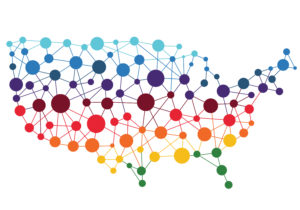
With more people working remotely during the COVID-19 pandemic, it’s not surprising to also see hiring for available jobs going online. Increasingly, colleges, communities, and companies are turning to virtual job fairs to fill vacant positions.
Benefits of Virtual Job Fairs
For prospective employees, virtual job fairs are cheaper and more convenient. There’s no need to commute to a location and wait in line to speak to employers. The job seeker can access multiple employers from the comfort of home.

Virtual job fairs also allow participation no matter where a prospective employee happens to be located. If you live in a rural area where job fairs are uncommon, you can still get your resume to recruiters. With geography not an obstacle—with candidates potentially from anywhere in the world—there is more opportunity for both the job seeker and the employer.
For employers, cost is certainly one of the big reasons to hold job fairs online. They don’t require any travel or time away from work. And there’s no financial commitment for marketing and swag.
Virtual career fairs can also be set up from the office or home. Recruiters can talk with more than one candidate at a time, making the entire process more efficient.
Several companies offer virtual hiring event solutions. Jobcase recently announced it was offering a virtual hiring event platform to bring workers and employers together. Brazen, Career Fair Plus, BrandLive, and vFairs are some of the other companies which are also in the virtual career fair marketplace.
A Successful Candidate…
For job seekers, there are several things you can do to improve your chances for success at a virtual job fair.
First, do your homework. Choose the job fair featuring companies within your industry, with open positions for which you’re qualified, and in areas you want to live. That homework also includes knowing as much as you can about the companies to which you’ll be applying.
Second, make sure the area from which you’ll be virtually interviewing is clean. Take a look at your background from the perspective of your computer camera and get rid of anything that doesn’t look professional. Also make sure you’re in a distraction-free environment.

Third, dress for success. Yes, the job interview is virtual and seems to be fairly casual but how you’ll look on camera is just as important as how you look in person. Consider the virtual environment to be an extension of the professional one, and dress accordingly.
Fourth, get your resume ready. If you’ve done your homework and know the companies to which you’ll be applying, try to tailor your resume to the individual needs of each, if possible. Make sure you’ve proofread it. And make certain you can access it quickly so you can email to recruiters.
Fifth, prepare a list of questions to ask each employer. They should be related to the company or position in which you are interested.
Sixth, make sure your tech works. You don’t want to be in the middle of a video conversation and have your internet connection drop or your battery die.
Seventh, speak professionally. Unless they say otherwise, address recruiters as Mr. or Ms. And don’t use emoticons when typing.
Eighth, follow up. Sending thank you notes to everyone you’ve spoken with is a great way to keep yourself top of mind. Try to include something specific that you discussed or enjoyed about the conversation, and let them know you are interested in moving to the next step in the process.
Solidify Your Resume
For help in getting that resume together the labor market data analytics firm Emsi has created a Resume Optimizer that allows users to tailor resumes for the types of the jobs they are seeking. The tool lets users compare their listed skills to those in job postings. It also helps job-hunters determine which skills to highlight—and even add or remove from their resumes.

Kelly Bailey, Director of Emsi Open Skills, introduced the free tool. Bailey says the just-released version is a prototype. She says, “We will be adding enhancements and are inviting feedback from users.”
The Resume Optimizer is built using Emsi’s data—which is collected from government sources, job listings, online profiles and resumes—and Application Programming Interfaces (APIs).
Bailey says coming soon, Emsi plans to launch a Job Posting Optimizer so employers can write more accurate, well-communicated hiring opportunities.
Emsi provides labor market data to professionals in higher education, economic development, workforce development, talent acquisition, and site selection.

Virtual Job Fair Resources
Finding virtual job fairs isn’t difficult, but it does take a little bit of digging. This list of resources will, hopefully, make the job search a little easier.
Jobfairsin.com offers a full list of available job fairs and virtual job fairs throughout the country.
CareerEco connects students and alumni with employers and grad schools.
PracticeMatch has virtual career fairs that match doctors and medical employers.
DHi Career Events has a list of virtual career fairs in technology and engineering.
The Urban League of Louisiana has a calendar of virtual job fairs aimed at getting people through the COVID-19 pandemic and beyond.
The Disabled American Veterans Organization has a list of virtual job fairs for those who have served in the military.
Black Virtual Career Fair (BVCF) connects talented Black professionals to progressive companies committed to building a diverse and inclusive workforce.
The Society of Women Engineers has a virtual career fair set up for the end of April 2020.











